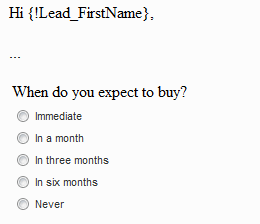Much has been written about the diminishing success of mass emails and how to develop new strategies that engage your prospects and customers. If you are up-to-date on this then you have probably recognized that it is no small task, not without its own challenges and pitfalls.
From its inception, BizConnector / Lead Follow-Up was built with bi-directional communication in mind. It incorporates the notion that communication is a series of ongoing ‘conversations’ with prospects and customers, and that each conversation is potentially different, just as much as each prospect or customer is potentially different. This is antithetical to the ‘one size fits all’ approach fundamental to the mass emailing model.
A conversation is an interaction between two parties. The term ‘interaction intelligence’ includes, among other things, how relevant one party’s messages are to the other. The more relevant a message, the more likely it will be taken into account by the other party.
Now bring automation into the picture. Automation-interaction intelligence measures how well you do all this automatically.
To be able to send relevant messages using an automated application requires that the application is sensitive not only to differences between its stored prospect and customer profiles, but that it is also sensitive to changes – in real time – in these profiles, and can react accordingly.
Not too many products do this successfully, and the reason for this may lie in their core architecture.
BizConnector / Lead Follow-Up does do this successfully. The main reason for this stems from its core architecture – manifested by (near) real time business rules (see What Is A Business Rule). The other is the Instant Feedback feature (see Getting Instant Feedback) that updates recipient responses in real-time.
These two mechanisms work symbiotically to respond sensitively to the profiles and stated needs of the target population, effectively raising its interaction intelligence through automation.
An Example:
If all this sounds too theoretical, then the following simple example may help to illustrate.
Let’s assume prospect records contain a field called ‘Product Interest’. This (required) field is populated initially by a prospect submitting a form on your website. Let’s say that for one prospect the field value starts off as ‘Product A’.
Let’s say you have two rules; Rule A firing and sending relevant emails over a period for ‘Product A’ prospects and another, Rule B, sending relevant emails over a period for ‘Product B’ prospects.
The above describes an ongoing ‘triggered email’ marketing environment in which prospects are receiving information (drip emails) relevant to their stated needs.
But in one or more of these emails you have an embedded ‘Instant Feedback’ question, and a prospect who initially requested ‘Product A’ information has changed her mind – now she wants ‘Product B’ information. She clicks ‘Tell me about Product B’ in the email.
Rule A immediately stops, and Rule B starts, for this prospect. The effect of this is that emails describing Product A are suppressed, and emails describing Product B start arriving in the recipient’s inbox.
Now wouldn’t you call that automated-interaction intelligence?


